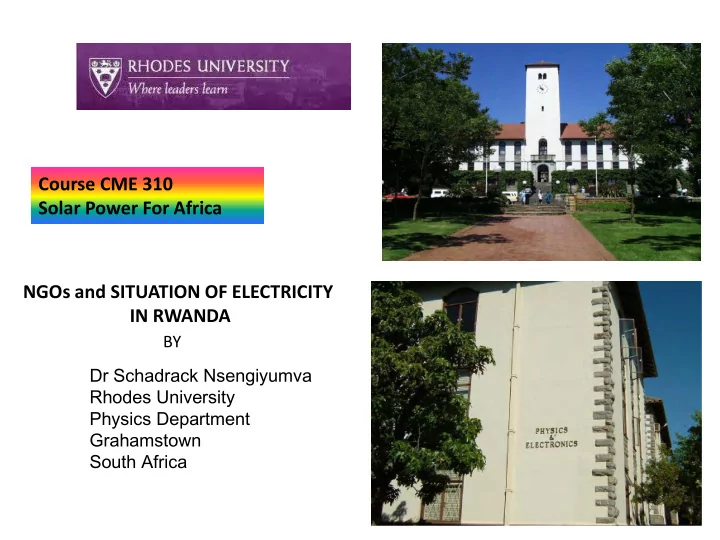

Course CME 310 Solar Power For Africa NGOs and SITUATION OF ELECTRICITY IN RWANDA BY Dr Schadrack Nsengiyumva Rhodes University Physics Department Grahamstown South Africa
RWANDA Capital (and largest city) Kigali Official languages Kinyarwanda, English, French Demonym Rwandan, Rwandese Government Unitary parliamentary democracy and presidential republic President Paul Kagame Prime Minister Pierre Habumuremyi Independence (from Belgium) 1 July 1962 Area 26,338 km 2 or 10,169 sq mi (138 th /236) Water (%) 5.3 Population 2011 estimate: 11,370,425 (81rd/225) 2001 census: 8,162,715 419.8/ km 2 or 1,087.2/ sq mi (31 st /241) Density GDP (ppp) 2011 estimate: total $13.109 billion per capita: $1,284 Currency Rwandan franc (RWF)
NGOs This term was mentioned in 1945 when UN was created. Refers organizations that do not form part of the government and are not conventional for profit-business. In cases in which NGOs are funded totally or partially by governments, NGO maintains its non-governmental status by excluding government representatives from membership in the organization. In many jurisdictions, these NGOs are called civil society organizations (CSOs) or referred to by other names. NGOs are mainly involved in humanitarian issues, development aid and sustainable development.
Role of NGOs in aftermath of Rwanda genocide In the aftermath of the genocide, NGOs emerged to help in addressing social needs, including assistance to widows and orphans, child-headed households, and traumatized survivors. Today, 128 NGOs are registered in Rwanda and operating in different districts NGOs continue to provide essential social assistance to the Rwandan people. Approximately 80 percent of NGOs in Rwanda carry out health and education-related activities, while 20 percent provide other social services .
Role of NGOs in aftermath of Rwanda genocide Aid effectiveness: transparent in the management of resources, minimize the operational cost, development activities with impact on the ground. Should not get engaged in subversive political activities contrary to ethics governing NGOs or present the government programmes as their owns to get more funds. Recently, it was revealed that some NGOs are not transparent in the management of their resources and indicate in their reports having spent more than 75 % of their budget on operational costs. Other NGOs operate without registration and donors continue to deal with them
SITUATION OF ELECTRICITY IN RWANDA
Country Generation capacity (MW) Angola 343 Botswana 400 DRC 1136 Lesotho 28 Malawi 104 Mozambique 912 Namibia 800 RSA 6639 Swaziland 20 Tanzania 260 Zambia 1350 Zimbambwe 1315 Total 13307
Energy cost: $0.22/Kwh. Rest of the region: $0.08 - $0.10/KWh South Africa: $0.04/KWh
SOLAR ENERGY OVERVIEW Sun very basis of the existence of life on our planet Driving force behind other sources of energy such as wind, biomass and hydro. Sunlight can be transformed into electrical energy through solar photocell systems. In Rwanda, solar energy has been exploited in recent decades by local and international organizations for the electrification of churches, schools and households in rural areas The potential for solar energy in Rwanda is 4.5-5.5 kWh/ m 2 / day at an average of 8 hours of sunshine a day. However, the relatively high cost of solar systems has been a barrier to widespread dissemination until now. Currently, solar energy is mainly used for two purposes in Rwanda: 1. Electric power production through solar photovoltaic systems 2. Direct heating, for example solar water heaters
Average Solar insolation figures (Measured in kWh/m 2 /day onto a horizontal surface) 1. Rwanda/Kigali Jan Feb Mar Apr May Jun Jul Aug Sep Oct Nov Dec 4.86 5.15 4.9 4.77 4.65 4.77 5.08 5.03 5 4.62 4.48 4.5 2. Germany/Muenchen Jan Feb Mar Apr May Jun Jul Aug Sep Oct Nov Dec 1.12 1.94 2.94 4.1 5.09 5.29 5.29 4.65 3.2 1.9 1.15 0.86 3. USA/Los Angeles Jan Feb Mar Apr May Jun Jul Aug Sep Oct Nov Dec 2.93 3.62 5.12 6.6 7.49 7.83 7.54 6.87 5.7 4.45 3.34 2.73 4. Australia/Brisbanne Jan Feb Mar Apr May Jun Jul Aug Sep Oct Nov Dec 6.19 5.39 4.95 3.98 3.23 3.02 3.22 4.04 5.12 5.52 6.07 6.35 5. South Africa/Johannesburg Jan Feb Mar Apr May Jun Jul Aug Sep Oct Nov Dec 6.59 6.02 5.48 4.84 4.3 3.96 4.27 5.05 5.88 5.96 6.45 6.67
There are 6 players active in the Rwandan solar energy sector 1. SECAM 2. MODERN TECHNICAL SERVICES (MTS) 3. DAVIS & SHIRTIFF 4. GREAT LAKES ENERGY 5. EPS RENEWABLE 6. SOLAR ELECTRIC LIGHT FUND (SELF) They are the primary repositories of solar skills as well as a number of independent contractors.
Rubaya Health Center • K-Light Solar Lantern Synergy Rwanda • Solar power system installation in East Africa Kirambo Health Center
Solar Electric Light Fund (SELF) Installation of solar power to PIH clinics in Eastern Rwanda. Supply of solar energy for refrigeration Computer recordkeeping In labs, powers microscopes, blood analysis machines, centrifuges, sterilization devices Photovoltaic park on a hill near Kigali: Kigali Solar (peak output of 250 kW). Installation by Mainz’s utility Company (Rhineland-Palatinate/Germany)
Solar Light for Africa (SLA): Non-profit Christian organization whose mission is to transform lives and empower the people of Africa by providing light and energy using the natural power of the sun.
Izuba (sun) energy solutions (local company): goal is to indulge in the renewable energy developments
Ministry of infrastructure(MININFRA ) Project: Idea of Solar Kiosks, which will consist of a central solar battery charging station, where rural communities can rent charged batteries for a small fee to power their lighting and equipment at home. Solar Power for Africa in collaboration with Solar Light for Africa The World Bank is currently supporting a major rural electrification initiative. It is expected to provide the government rural electrification programmes with considerable resources, a significant portion of which will be renewable. Government administration: The energy supply of the 496 government offices is as follows: 146 centrally supplied by Electrogaz, 205 supplied by solar PV(116), diesel generators (86), micro hydro (3), and 145 un- electrified.
Recommend
More recommend